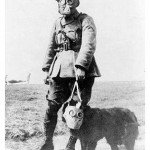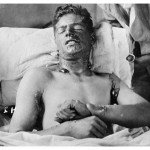
The stalemate on the Western Front prompted the most intensive use of chemical weapons in human history. Despite an 1899 treaty that banned the military use of poisonous gas, all major combatants of the war used them at one point or another, especially during 1915 and 1916. Initial uses of poison gas were with irritants like tear gas, intended to inconvenience and temporarily disable the enemy, rather than to cause death. The French used tear gas in grenades in the first month of the war, the Germans reciprocated not long after. These early attempts used small amounts of gas which either froze or were quickly dispersed by the weather; as a consequence they had little impact. In January 1915 the Germans initiated chemical warfare on a larger scale, launching a barrage of tear gas shells against Russian soldiers.
German scientists were also busy refining and producing chlorine: a gas to kill rather than just inconvenience. A by-product of clothing manufacture, chlorine gas was released upwind of enemy positions. It drifted at ground level, appearing first as a pale green cloud, followed soon after by a noxious smell reminiscent of swimming pools and bleach. Once inhaled, the chlorine infiltrated and corroded the lungs, causing painful suffocation and an excruciating death. The initial deployment of chlorine against French, British and Canadian troops was both devastating and frightening, causing considerable panic in their ranks. But the Allies soon developed strategies and counter-measures to deal with chlorine attacks. Gas masks containing chemically-impregnated cotton filters were effective at protecting soldiers from chlorine gas. Even holding a rag soaked with water or urine over one’s mouth and nose offered some protection.
“The use of chemicals left an abhorrent image of helpless soldiers in makeshift gas masks, struggling for breath, or ranks of soldiers blinded by mustard agent attacks. In reality though, chemical weapons caused relatively few deaths and injuries compared to conventional weapons. When the war was over, chemical weapons had caused less than 4 per cent of all casualties… One could ask why they have gained such a fulsome reputation when their use did not fundamentally affect the course of World War I, or arguably of any war since then.”
Eric Croddy, writer
The British, incensed by Germany’s use of poison gas, began producing their own stocks. The first Allied chlorine gas attack, in September 1915, was disastrous: a change of wind blew the gas away from the German trenches, some of it instead reached the British line and killed soldiers there. In the same year French chemists invented an even more potent substance called phosgene. Unlike chlorine, phosgene was invisible and had a fainter smell, so its presence was more difficult to detect. Phosgene also caused lung damage and suffocation, though its effects were not immediate (one could ingest it but suffer no ill effects for several hours). The Germans launched phosgene against British positions shortly before Christmas 1915, disabling more than 1,000 men. Phosgene would be responsible for more than three-quarters of the gas fatalities during World War I.

The most notorious chemical weapon of the war was mustard gas, a severe irritant which caused chemical burns on the skin, the eyes and in the airways. Though not as deadly as other compounds, mustard gas probably had more effect as an anti-personnel weapon. Gas masks could be used to negate the effects of phosgene or chlorine, but mustard gas caused injury wherever there was exposed skin. It also settled on the ground as an oily liquid and could remain active and dangerous for days, even weeks depending on the weather. The pain of mustard gas was intense and its psychological impacts profound. Those exposed to it developed large painful yellow blisters, while men with severe doses died agonising deaths as their lungs burned and blistered inside them. Many mustard gas victims were blinded, some permanently, while some survivors endured respiratory problems for the rest of their lives.
It is not surprising that gas attacks were the trench soldier’s worst fear, as recounted in this Wilfred Owen poem:
Gas… GAS! Quick boys! An ecstasy of fumbling,
Fitting the clumsy helmets just in time.
But someone still was yelling out and stumbling,
And flound’ring like a man in fire or lime.
Dim through the misty panes and thick green light,
As under a green sea, I saw him drowning.
In all my dreams, before my helpless sight,
He plunges at me, guttering, choking, drowning.

Germany was the most active exponent of chemical warfare during 1915, but by 1917 this situation had reversed, with the Allies producing several thousand tons of poison gas. Scientists in the United States invented a new compound called Lewisite: it had similar effects to mustard gas but was able to penetrate protective clothing and was allegedly more deadly. More than 20,000 tons were produced, trialled and stockpiled, though the end of the war came before it could be deployed on the battlefield. The horrors of gas warfare caused public indignation, both during and after World War I. In 1925 a Geneva convention was signed outlawing the use of chemical weapons. Adolf Hitler, who had himself been a victim of mustard gas in 1918, indignantly refused to deploy poison gas during World War II. Nevertheless the major powers retained stockpiles of these weapons – and indeed still do.

1. Despite an 1899 treaty banning their use, both sides entered the war with stockpiles of chemical weapons.
2. Chemical weapons began with the deployment of tear gas grenades in 1914, followed by chlorine gas in 1915.
3. Germany was the most prolific manufacturer and user of gas, though the Allies reciprocated and soon caught up.
4. Deadly gases like phosgene and chlorine were used but mustard gas was the most common chemical weapon.
5. The effects of chemical weapons caused outrage, particularly after the conclusion of the war, which led to international treaties banning their use in wartime.
© Alpha History 2014. Content on this page may not be republished or distributed without permission. For more information please refer to our Terms of Use.
This page was written by Jennifer Llewellyn, Jim Southey and Steve Thompson. To reference this page, use the following citation:
J. Llewellyn et al, “Chemical weapons” at Alpha History, https://alphahistory.com/worldwar1/chemical-weapons/, 2014, accessed [date of last access].
